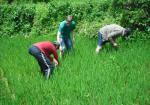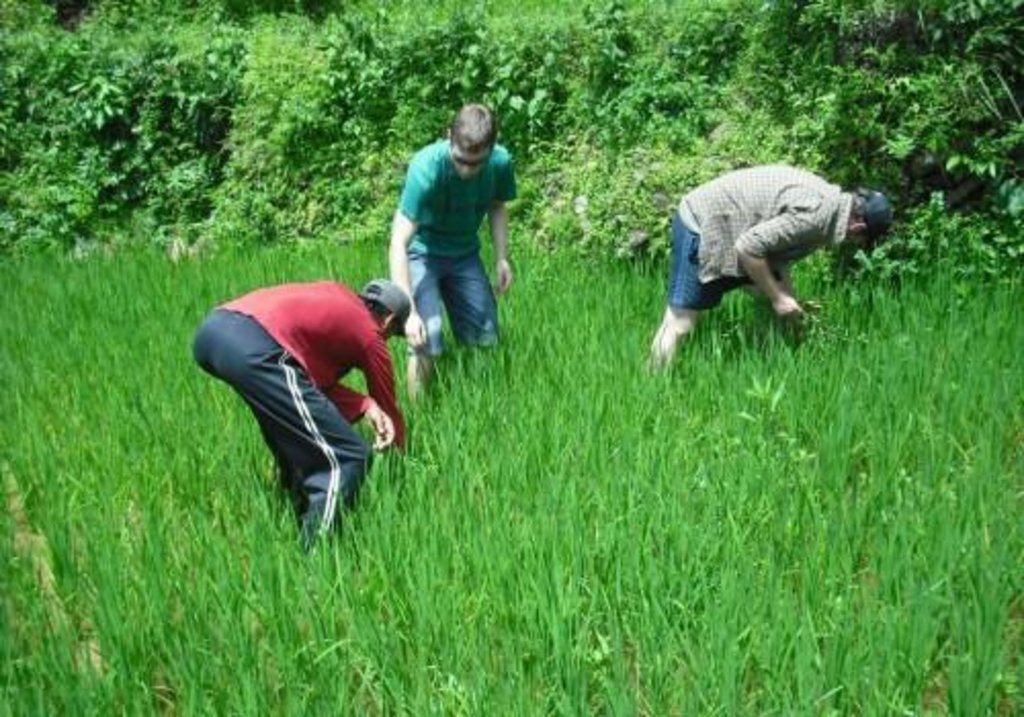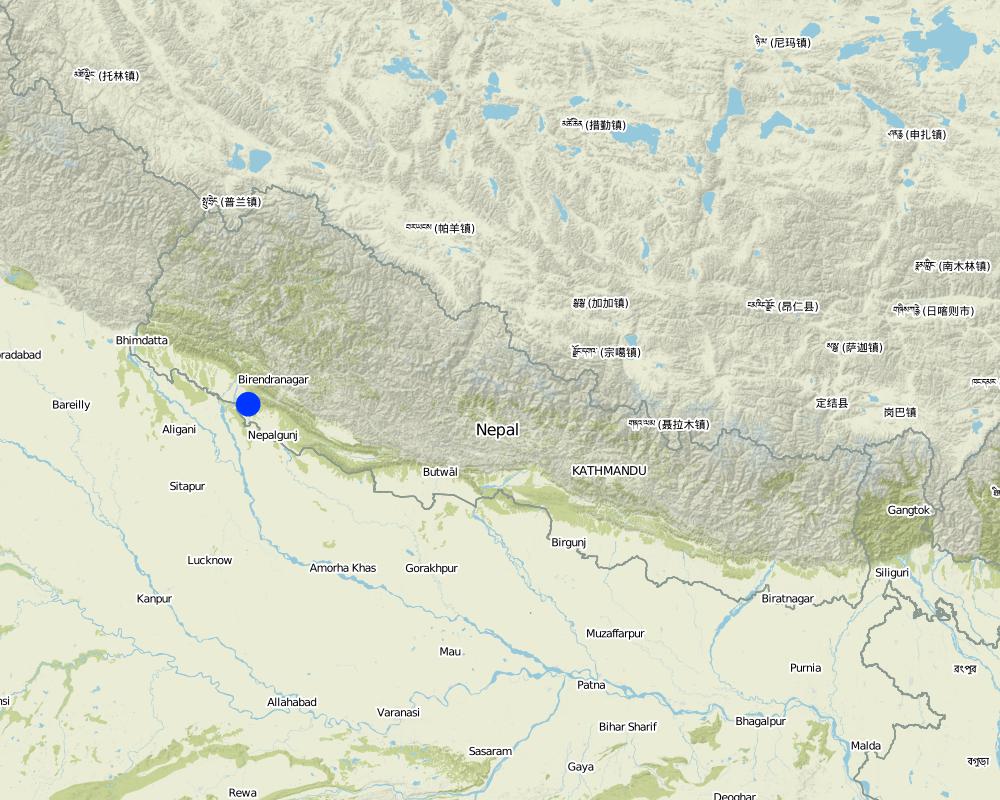Promotion of Sesbania species(as green manures for rice cultivation) [เนปาล]
- ผู้สร้างสรรค์:
- การอัพเดท:
- ผู้รวบรวม: Sabita Aryal
- ผู้เรียบเรียง: –
- ผู้ตรวจสอบ: Fabian Ottiger
Dhaincha Prabardhan
approaches_2483 - เนปาล
ดูส่วนย่อย
ขยายทั้งหมด ย่อทั้งหมด1. ข้อมูลทั่วไป
1.2 รายละเอียดที่ติดต่อได้ของผู้รวบรวมและองค์กรที่เกี่ยวข้องในการประเมินและการจัดเตรียมทำเอกสารของแนวทาง
ผู้เชี่ยวชาญ SLM:
Acharya Shiva
Local farmer Gumi-3 Surkhet,Nepal
เนปาล
ผู้เชี่ยวชาญ SLM:
Regmi Dambar
Local farmer Gumi-3 Surkhet,Nepal
เนปาล
ผู้เชี่ยวชาญ SLM:
Gurung Thek
Local farmer Gumi-4, Surkhet,Nepal
เนปาล
ชื่อของโครงการซึ่งอำนวยความสะดวกในการทำเอกสารหรือการประเมินแนวทาง (ถ้าเกี่ยวข้อง)
Kathmandu University (KU) - เนปาล1.3 เงื่อนไขที่เกี่ยวข้องกับการใช้ข้อมูลที่ได้บันทึกไว้ผ่านทาง WOCAT
ผู้รวบรวมและวิทยากรหลักยอมรับเงื่อนไขเกี่ยวกับการใช้ข้อมูลที่ถูกบันทึกผ่านทาง WOCAT:
ใช่
2. คำอธิบายของแนวทาง SLM
2.1 การอธิบายแบบสั้น ๆ ของแนวทาง
Green manure-It is a way of adding nutrients and organic matters to soil by incorporating green manure plants which include both leguminous or non-leguminous plants. Sesbania, also known as Dhaincha, i.e. a diverse and versatile genus belonging to the family Fabaceae,which is soft,woody,annual or short lived perennial;primarily used as green manure between rice crops or as an intercrop in transplanted rice.
2.2 การอธิบายอย่างละเอียดของแนวทาง
การอธิบายอย่างละเอียดของแนวทาง:
Aims / objectives: -Leguminous green plants like Sesbania can fix atmospheric nitrogen in the form that plant can use.
-It helps to improve the soil structure as incorporating it into the soil adds organic matterr (biomass).
-The Sesbania species has high water-logging tolerance which prevents the crop from losing its nutrient content.
Methods: In nepal,institutions like NARC and research programs like Rice Research program has actively promoted Sesbania species. Dr. Bhola man singh basnet of Nepal Agriculture Research council(NARC),khumaltar has extensively carried out his research on green manure using Sesbania, which is called locally as Dhaincha.
The Hardinath Agriculture Farm in Dhanusha,now National Rice Research Program, practiced Sesbania cannabina, dhaincha as pre-rice manure annually in 20 ha for more than 20 years.
Green manure technique is an indigenous practice mainly in the foothills, middle mountains region and central terai of nepal-dhanusha,parsa,bara and Rautahat district.
Stages of implementation: Sesbania is sown before rice is planted.Sow the Sesbania seed densly and lightly cover the seed with soil.Sesbania will grow faster if the soil is kept moist.After 4-6 weeks sesbania will be 18-36 inches tall at ground level and plough in as the paddy are prepared for planting rice.
Seed production process;
Transplant a few of the largest,thickest,healthiest plant into the edges of paddy space at 2 metre intervals along the terrace edges.Seed will be ready after 6 -7 months.This can be used as seed for green manure next year.
Role of stakeholders: Government;
-Institutional roles; NARC, HAF -DDC-Municipality-VDC
Private sectors;
-Desigining policies.
Other important information: -Sesbania species can be grown even under adverse conditions of drought,waterlogging,salinity,etc.
-optimum time of Daincha seed production is the middle of March until the end of May .
-Experiment conducted at several research stataions showed that green manureing with dhaincha in rice increased the grain yields by about 20-25 percent(Pre rice green manure-a success story,B.H.S Basnet,NARC)
2.3 รูปภาพของแนวทาง
2.5 ประเทศ ภูมิภาค หรือสถานที่ตั้งที่ได้นำแนวทางไปใช้
ประเทศ:
เนปาล
ภูมิภาค/รัฐ/จังหวัด: :
Nepal
ข้อมูลเฉพาะเพิ่มเติมของสถานที่ตั้ง:
Surkhet
Map
×2.7 ประเภทของแนวทาง
- แบบดั้งเดิม/ แบบพื้นเมิอง
2.8 เป้าหมายหรือวัตถุประสงค์หลักของแนวทาง
The Approach focused mainly on SLM with other activities (Sesbania species increases nutrient content of the soil,due to its water logging tolerance and also increases the fertility,biomass production in the fields as well as nitrogen content of the soil by fixing large amount of Nitrogen.)
-Increase the nutrient in the soil due to its water logging tolerance and thus increases the fertility and productivity.
-Also reduce the need of artificial fertilizers
The SLM Approach addressed the following problems: Low knowledge about the green manuring among people because of which they were lured towards more use of particles and fertilizers.
Lack of improved seeds of green manure(plants).
2.9 เงื่อนไขที่เอื้ออำนวยหรือเป็นอุปสรรคต่อการนำเทคโนโลยีภายใต้แนวทางนี้ไปปฏิบัติใช้
การมีไว้ให้หรือการเข้าถึงแหล่งการเงินและบริการ
- เป็นอุปสรรค
-Improved and large seeds of green manure are costly.
-This can be reduced if we can make these seed locally available at subsidized rate.
Treatment through the SLM Approach:
กรอบแนวทางในการดำเนินการด้านกฎหมาย (การถือครองที่ดิน สิทธิในการใช้ที่ดินและน้ำ)
- เอื้ออำนวย
The existing land ownership, land use rights / water rights moderately helped the approach implementation: There was a bit hindrance.Seed cultivation requires both land use and irrigation system.
ความรู้เกี่ยวกับ SLM การเข้าถึงการสนับสนุนด้านเทคนิค
- เป็นอุปสรรค
-People were found unaware of the proper and new techniques of manuring.
Treatment through the SLM Approach: -Provide necessary information and conduct programs at local/regional level.
อื่นๆ
- เป็นอุปสรรค
The species shows better growth and higher biomass yield in the sandy clay than in heavy clay soil.
Treatment through the SLM Approach: The areas with sandy clay loam should be identified if we are to except a high crop yield.
3. การมีส่วนร่วมและบทบาทของผู้มีส่วนได้ส่วนเสียที่เกี่ยวข้อง
3.1 ผู้มีส่วนได้ส่วนเสียที่เกี่ยวข้องในแนวทางนี้และบทบาท
- ผู้ใช้ที่ดินระดับท้องถิ่นหรือชุมชนระดับท้องถิ่น
Farmers community
Men were involved more, because of the hard work in the field.. Many people are using the green manure technique to increase the crop yield but no any incentives and support has been provided by government institutions targeting the socially and economically disadvantaged groups.
- รัฐบาลระดับท้องถิ่น
Hierarchy;District Development comittee-Municipality-VDC
- รัฐบาลแห่งชาติ (ผู้วางแผน ผู้ทำการตัดสินใจ)
Ministry of agriculture
3.2 การเกี่ยวข้องของผู้ใช้ที่ดินระดับท้องถิ่นหรือชุมชนระดับท้องถิ่นในช่วงต่างๆของแนวทาง
| ความเกี่ยวข้องของผู้ใช้ที่ดินระดับท้องถิ่นหรือชุมชนระดับท้องถิ่น | ระบุผู้ที่มีส่วนเกี่ยวข้องและอธิบายกิจกรรม | |
|---|---|---|
| การริเริ่มหรือการจูงใจ | ระดมกำลังด้วยตนเอง | Farmers |
| การวางแผน | ปฏิสัมพันธ์ | Involvement of individuals (farmers) at the begining.Gradually supported by many institutions. |
| การดำเนินการ | ระดมกำลังด้วยตนเอง | Sesbania is a local species available in Nepal since 1960 and used as green manure by farmers land users to increase productivity and field of crops. |
| การติดตามตรวจสอบหรือการประเมินผล | ไม่ลงมือ | Gradual progress and support from government and institutions. |
| Research | จ่ายเงินหรือสนับสนุนจากภายนอก | Research being carried by institutions, on nutrient content and new species of green manure plant. |
3.4 การตัดสินใจเลือกใช้เทคโนโลยี SLM
ระบุผู้ที่ทำการตัดสินใจเลือกเทคโนโลยีมากกว่าหนึ่งวิธีไปปฏิบัติใช้:
- ผู้ใช้ที่ดินเป็นผู้ตัดสินใจหลัก โดยการสนับสนุนจากผู้เชี่ยวชาญ SLM
การอธิบาย:
Green manuring using Dhaincha is an indigenous practice which is currently supported and motivated by many institutions.
Decisions on the method of implementing the SLM Technology were made by by land users* alone (self-initiative / bottom-up). Due to the dissatisfaction by the use of the fertilizers(artifical) land users themselves initiated the approach for better production.
4. การสนับสนุนด้านเทคนิค การสร้างขีดความสามารถ และการจัดการด้านความรู้
4.1 การสร้างขีดความสามารถ / การอบรม
ได้มีการจัดอบรมให้แก่ผู้ใช้ที่ดินหรือผู้มีส่วนได้ส่วนเสียคนอื่น ๆ หรือไม่:
ไม่ใช่
4.2 การบริการให้คำแนะนำ
ผู้ใช้ที่ดินมีการเข้าถึงการรับบริการให้คำปรึกษาหรือไม่:
ใช่
การอธิบาย/แสดงความคิดเห็น:
Name of method used for advisory service: Participatory community-based approach.; Many people including farmers, land users participate,discuss and conclude about the way of practicing of green manuring.
Advisory service is quite adequate to ensure the continuation of land conservation activities; Government and institution are the one that make the seeds of green manure plant available to the local farmers.So their contribution and continuation of land conservation activities cannot be neglected.
4.3 การเสริมความแข็งแกร่งให้กับสถาบัน (การพัฒนาองค์กร)
สถาบันได้รับการจัดตั้งขึ้นมาหรือเสริมความแข็งแกร่งโดยแนวทางนี้หรือไม่:
- ใช่ ปานกลาง
ระบุระดับของสถาบันที่ได้รับการเสริมความแข็งแกร่งหรือจัดตั้งขึ้นมา:
- ท้องถิ่น
ระบุประเภทของการให้ความช่วยเหลือสนับสนุน:
- การสร้างขีดความสามารถ / การอบรม
ให้รายละเอียดเพิ่มเติม :
Documentation of the approach provide training to the land users about green manure techniques.
4.4 การติดตามตรวจสอบและประเมินผล
การติดตามตรวจสอบและประเมินผลเป็นส่วนหนึ่งของแนวทางหรือไม่:
ใช่
ความคิดเห็น:
bio-physical aspects were regular monitored by government through observations; indicators: Nutrients like N,P,K are monitered at a regular basis by and institutioons like NARC,HAF.government land users(farmers)
economic / production aspects were regular monitored by land users through observations; indicators: crop yield per hectare.
There were few changes in the Approach as a result of monitoring and evaluation: seed varities of sesbian species shows better growth in sandy clay than heavy clay soil. so, the soil type needs to be considered.
4.5 การวิจัย
การวิจัยเป็นส่วนหนึ่งของแนวทางหรือไม่:
ใช่
ระบุหัวข้อเรื่อง:
- นิเวศวิทยา
ให้ข้อมูลเพิ่มเติมและให้ระบุผู้ทำการวิจัย:
Research was carried out on-farm
5. การสนับสนุนด้านการเงินและวัสดุอุปกรณ์
5.1 ระบุงบประมาณประจำปีสำหรับแนวทาง SLM นี้
ถ้าหากว่างบประมาณประจำปีไม่เป็นที่ทราบแน่นอน ให้ระบุช่วงลงไป:
- < 2,000
5.2 การสนับสนุนด้านการเงิน / วัสดุอุปกรณ์ให้แก่ผู้ใช้ที่ดิน
ผู้ใช้ที่ดินได้รับการสนับสนุนด้านการเงิน / วัสดุอุปกรณ์ไปปฏิบัติใช้เทคโนโลยีหรือไม่:
ใช่
ถ้าใช่ ให้ระบุประเภทของการสนับสนุน เงื่อนไขและผู้จัดหามาให้:
Governmental Aid.
5.3 เงินสนับสนุนสำหรับปัจจัยนำเข้า (รวมถึงแรงงาน)
ความคิดเห็น:
Green manure seeds are distributed by the government to the local bodies;from where the seeds are sold to the land users/farmers.
5.4 เครดิต
มีการจัดหาเครดิตมาให้ภายใต้แนวทาง SLM หรือไม่:
ใช่
6. การวิเคราะห์ผลกระทบและการสรุป
6.1 ผลกระทบของแนวทาง
ช่วยให้ผู้ใช้ที่ดินนำเอาเทคโนโลยี SLMไปใช้และบำรุงรักษาสภาพไว้ได้หรือไม่:
- ไม่ใช่
- ใช่ เล็กน้อย
- ใช่ ปานกลาง
- ใช่ อย่างมาก
- it increases the fertility and nutrient content of the soil due to its water logging tolerance. -Helps control soil erosion. -It also improve the quality of soil and crops.
ทำให้กลุ่มด้อยโอกาสมีอำนาจทางสังคมและเศรษฐกิจหรือไม่:
- ไม่ใช่
- ใช่ เล็กน้อย
- ใช่ ปานกลาง
- ใช่ อย่างมาก
Poor farmers earn quite a good sum due to increase in yield and productivity by using sesbania as green manure.
The problem is likely to be overcome in the near future.
Did other land users / projects adopt the Approach?
- ไม่ใช่
- ใช่ เล็กน้อย
- ใช่ ปานกลาง
- ใช่ อย่างมาก
NARC which provide training as well as focus on the practice of green manuring which help all the villagers to get benefitted.
Did the Approach lead to improved livelihoods / human well-being?
- ไม่ใช่
- ใช่ เล็กน้อย
- ใช่ ปานกลาง
- ใช่ อย่างมาก
using sesbania species as green manure increases the production of rice in the farms. also reduce the expenses for buying of artificial fertilizers from suppliers.
Did the Approach help to alleviate poverty?
- ไม่ใช่
- ใช่ เล็กน้อย
- ใช่ ปานกลาง
- ใช่ อย่างมาก
increase the productivity and crop yield which lead to the rise in economic status of people by selling the grains on market.
6.2 แรงจูงใจหลักของผู้ใช้ที่ดินเพื่อที่จะนำ SLM ไปปฏิบัติใช้
- การผลิตที่เพิ่มขึ้น
increase in the crop productivity.
6.3 ความยั่งยืนของกิจกรรมของแนวทาง
ผู้ใช้ที่ดินสามารถทำให้สิ่งต่างๆ ที่ได้ปฏิบัติใช้โดยแนวทางนี้ยั่งยืนได้หรือไม่ (โดยไม่มีการสนับสนุนจากภายนอก):
- ใช่
ถ้าตอบว่าใช่ ให้อธิบายว่าอย่างไร :
Since it is easy and natural method to increase the fertility of the soil,farmers can be benifited..it only requires the basic knowledge about the seasons and seeds(improved) so it can be easily implemented.
6.4 จุดแข็งและข้อได้เปรียบของแนวทาง
| จุดแข็ง / ข้อได้เปรียบของแนวทางในทัศนคติของผู้ใช้ที่ดิน |
|---|
|
-if some species of sesbina like Sesbania cannabina are established as an intercrop in rice. -During short Day season,vegetative growth of the plant is reduced due to early flowering. -Many Sesbania species are being over ploited. -Improved seeds of sesbian sp, are costly and this technique requires a lot of labour work, people are in more favour of artificial chemical fertilizers. (How to sustain/ enhance this strength: -it can be suppressed by the rice if sown 30-60 days after crop. -These sp. should be sowed in the middle of March to end of vegetables growth. -Attention must be given to the conservation and proper utilization of these important plant species. -Government /local bodies should make it available at cheaper rate and encourage people to revive interest in green manures.) |
| จุดแข็ง / ข้อได้เปรียบของแนวทางในทัศนคติของผู้รวบรวมหรือวิทยากรหลัก |
|---|
|
-Increase the fertility of the soil. -it can help to increase the biomass in the soil. -Increases microorganisms and their activity in the soil. (How to sustain/ enhance this strength: They can be enhanced if the present trend of exploiting green manuring plants are changed to develop their production on a sustainable basis.) |
7. การอ้างอิงและการเชื่อมต่อ
7.1 วิธีการหรือแหล่งข้อมูล
- ไปเยี่ยมชมภาคสนาม การสำรวจพื้นที่ภาคสนาม
- การสัมภาษณ์กับผู้ใช้ที่ดิน
7.2 การอ้างอิงถึงสิ่งตีพิมพ์
ชื่อเรื่อง ผู้เขียน ปี ISBN:
Regenerative Agriculture Technologies for the Hill farmers of Nepal,'Nepal Rural Re-construction Association.The Farmers Handbook,'The Field' Ms. Hommaya GurungGreen Manure Production System For Asian Ricelands, J.K Ladha
ลิงก์และโมดูล
ขยายทั้งหมด ย่อทั้งหมดลิงก์
ไม่มีลิงก์
โมดูล
ไม่มีโมดูล





